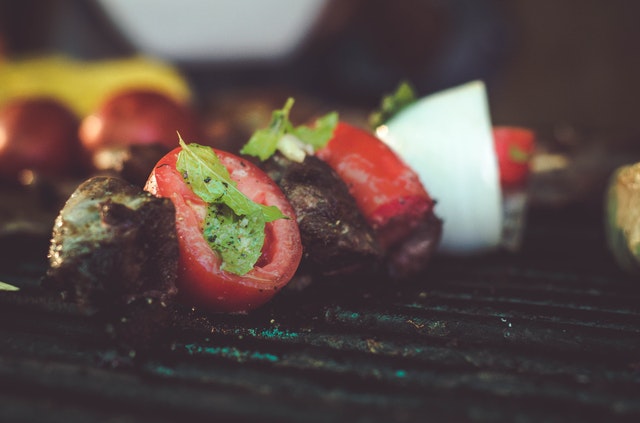
How to clean cast iron grill grates? Everything To Know
Cast iron grill grates are a great investment for those who have the time and patience to care for them. They can find in many shapes, sizes, and styles so no matter your preference there is a product to suit your needs. The benefits of cast iron grates include being able to retain heat better than other materials as well as being natural non-stick surface without requiring seasoning or oiling.
However, they do require some maintenance if you want them to stay in good condition. This blog post will give you some quick and easy tips on how to clean cast iron grill grates so that you can enjoy your next outdoor meal with family and friends. Cleaning your cast iron grill grates does not have to be a chore! With these simple tips, you will find yourself cleaning up much quicker than before. Read on for more information about this topic!
Table of Contents
What is the cast iron grill grates?
Cast iron is an alloy of mostly iron with some carbon (unlike wrought iron) and no slag. It has made from its natural occurrence in meteorites since before the start of the Bronze Age. Making it by melting pig iron, often along with substantial quantities of scrap iron and scrap brass, the alloy known as pig iron.
The term “grates” means the framework of the bars, rods, plates, or other elements used as a support for the cooking utensils and retaining the solid fuel (wood, coal, etc.) within the fireplace. The fire grate may be fitted into the home fireplace or designed as a free standing component in the yard. Cast iron grill grates are made of cast iron, which is a type of ferrous metal. It has known for its durability and heat retention properties, as well as its ability to withstand the elements. Cast iron grill grates are ideal for cooking over an open fire or charcoal grill, as they heat evenly and produce a nice, crispy crust on your food.
In the past, cast iron grill grates have used in blacksmithing and other types of metalworking. However, over time, people began to realize that they could been used for cooking purposes.
The first cast iron grill grates has used by the ancient Greeks and Romans. They would use them to cook food over an open fire. Cast iron grill grates are very durable and can withstand high temperatures. They are also able to distribute heat evenly, which results in evenly cooked food. Today, cast iron grill grates are a popular choice for backyard BBQ enthusiasts and professional chefs alike. They can last for many years if cared for properly.
Why should you use cast iron grill grates?
There are many different types of grill grates available on the market today. However, if you want the best possible grilling experience, you should use cast iron grill grates. Cast iron is a material that retains heat well, meaning your food will cook more evenly. Additionally, cast iron is durable and easy to clean; it will last for years with proper care, making it a great investment.
How to clean cast iron grill grates? There are many benefits to use cast iron grill grates, this post will show you a few reasons to help you make the decision:
- They give food a unique and delicious flavor. Cast iron grill grates give your food a unique flavor that you cannot get with any other type of grate. The metal absorbs the flavor of the food, which gives your grilled items a delicious taste.
- They are very durable and long lasting. Yes, cast iron grill grates are very durable. They can last a lifetime if you take care of them well. The carbon steel will probably rust, but the stainless version will not. Either way it is best to clean them as soon as possible or wipe dry after each use to prevent rust. Also, do not grease them unless necessary and then use a very light coating.
- They are easy to clean. Cast iron grill grates are easy to clean because they do not crack, warp or corrode. They can be cleaned using a stiff wire brush and scraping away the charred residue.
- They help keep food from sticking to the grill. Cast iron grill grates are great at distributing heat evenly, so your food cooks evenly on both the top and bottom. This also prevents food from sticking to the grill, making it much easier to clean up afterwards.
- They distribute heat evenly, resulting in perfectly grilled food every time. The porosity of cast iron grill grates helps to create those characteristic grill marks on your food. Grilling with cast iron grill grates is a healthy way to cook, because it allows some of the fat from meats and poultry to drip away while you are cooking.
Types of cast iron grill grates
There are several types of cast iron grill grates available on the market.
The most common types are cast iron grates with a porcelain enamel coating. These grates are easy to clean and they heat evenly. They are also non-stick, which makes them a good option for searing meats. For best results, the manufacturer suggests seasoning these types of grill grates with cooking oil or other types of fat.
The second type is the traditional cast iron grate. These types of grill grates last a lifetime and they can season naturally over time by absorbing smoke and grease from food. This process makes them nonstick and gives each grate its own unique patina. This type of grill grate is often more expensive than other types, but it also has its benefits. The enamel coating on porcelain-coated types of grates limits exposure to air as well as prevents rust. Quality manufacturers use an enamel coating that is thick and durable enough to withstand high heat without burning off, but this type of grill grate requires a bit more maintenance than the porcelain-coated types. Wood or charcoal briquettes are preferable over propane gas grills for seasoning these types of grates.
The most expensive types of types of cast iron grate are solid types made from titanium or graphite. These types are often adjustable and come with several types of accessories. These types of grill grates are also the easiest to clean and they can be-used on any type of grill, including open fire pits.
Finally, type of grill grate is the waffle grate. This grate has a series of raised ridges that create pockets of air between the food and the grate. This allows the food to cook more evenly and prevents it from sticking. Waffle grate are ideal for foods that need a little extra time to cook, such as chicken or pork chops.
So, which type of cast iron grill grate is best for you? It really depends on your needs and preferences. If you are looking for a grate that is easy to clean and heat evenly, then the porcelain enamel coated grate is a good option. If you are looking for a grate that can be-used for a long time, then the traditional cast iron grate is a good option. However, if you do not mind paying more money, then you might buy the solid cast iron grill grate.
No matter which type of cast iron grill grate you choose, you can rest assured that you will be getting a quality product that will last for years.
How to clean cast iron grill grates?
Cast iron grill grates can be a challenge to clean. They are often very dirty, and the dirt and grease can be difficult to remove. Because the cooking grates are not all big, they are especially challenging to clean properly.
If you own a grill with cast iron cooking grates, it is important for you to learn how to clean them. This will make the grates easier to use and more importantly, it will help prevent food poisoning. There are several different ways to clean cast iron grill grates, and the best way to clean them will depend on the particular type of grill that you have.
The first step in learning how to clean cast iron grill grates is to learn whether they are dishwasher safe. Most of them are too large for the dishwasher. If you plan to wash your grill grates by hand, it is important to heat up the cast iron grill grates before you even begin to clean them. This will burn off any food particles that may still be stuck on the grill grate. It also makes cleaning easier because the burned on food becomes much softer than it normally would be if not heated up first.
After they have been-heated, brush off as much loose debris as possible with a long-handled wire brush. Once all of the big pieces of debris have been-removed, it is time for you to use the brush to clean the grill grates. You can do this by dipping the brush into a soapy water solution and then scrubbing the grates. Be sure to pay close attention to the areas where food particles are likely to be stuck.
Next, rinsing them off with a water hose. If there is any stubborn dirt or grease that remains, you can use a metal polish to help remove it.
How to clean cast iron grill grates? Cast iron grill grates can also be-cleaned with oven cleaner. However, this should only be-done as a last resort because it can be very dangerous. Oven cleaner is toxic and it can be-damaged the grill grate if used incorrectly.
In conclusion, there are six steps to clean the cast iron grill grates, including:
- Soak the cast iron grill grates in hot water
- Clean the grill grates with a wire brush
- Spray them off with a water hose
- Scrub again to remove any remaining residue
- Dry the grates thoroughly before using again
- Finally, applying a thin layer of cooking oil to prevent rusting while not in use
How to clean cast iron grill grates? No matter which method you choose, it is important that you always clean your cast iron grill grates after each using. This will help to keep them in good condition and it will make them easier to clean. Failure to do so can lead to the build-up of harmful bacteria, which could cause food poisoning.
Choosing methods for cleaning the cast iron grill grates
First of all, the cast-iron grill grates need to be-cleaned after each use. It will take you just a few minutes and it is worth it. There are several methods to clean them:
The salt method
The salt method consists in sprinkling coarse sea salt over the hot grate which makes some steam come out of the pores while they cool down. The steam carries the burned residues with it along with the salt, so old fragile layers are -removed easily without damaging too much new seasoning on top of them. After that scrape everything off with a thin steel brush (a barbecue brush would do, but I think it is not fine enough). You can repeat this procedure if there are still greasy parts left, but do not repeat it too often because you could remove the seasoning all over.
Using a wet paper towel
You could also use a wet paper towel instead of salt, but only if the grates are still hot and there’s enough moisture in it. Otherwise, you will have to wait a bit before they cool down to be able to scrape. This method is easier though since you can leave the paper towel on for a few minutes without any risk of being-burnt by the heat. After scraping clean with water or vinegar then dry them well and oil them immediately to prevent rusting, that’s important!
The soap method
This one is simple: Just put some dishwashing liquid in warm water and scrub out everything with a brush while the grates are still hot. The grease will dissolve in the water, so you can easily drain it all off. Besides, be careful not to froth too much because it could drip over your burners and cause a small fire, or at least some smoke. Dispose of used dish soap properly. This method is good for removing old layers of seasoning only if they are -caked up.
The oven method
This method works great for stubborn burnt residues, but it has recommended when you have a gas grill with burners in the side “troughs” so that they do not get dirty. We have such a configuration on our Primo Oval XL, so I often have to resort to this method when the cast iron grates are-burnt, especially in between the troughs where drippings tend to accumulate and smoke a lot until cleaned out. What I do is turn off the burner(s) before putting the grates into the oven to heat them well. Then scrape away all greasy residues with a steel bristle brush and leave in the oven until they are completely dry. This way, I can remove all layers of burned grease in a single go without touching the seasoning on top of it at all. Do not do this when your burners are still hot though because you might melt the drip pan underneath.
How to clean cast iron grill grates? Although this article is about cleaning cast iron grill grates, you could also use this method for stainless steel grill grates, but be careful if they are very hot.
Choosing the tools for cleaning the cast grill grates
You have got plenty of options for cleaning your grill plates. From simple aluminum foil that you should have lying around the home to full on steam cleaners. We have a full guide for keeping your grill clean, you can check out a few options below.
A block of hardwood:
You can clean your grill plate while it is hot by throwing on a heatproof glove, and rubbing your grate with a block of hardwood. After some time, the wood will form grooves that are custom made for your grill!
Aluminum foil:
Lay some foil on the grate, weigh it down and crank your cooker for about 5 minutes. If you do not weigh the foil down the hot air will make it float up.
Use some tongs to take off the foil, scrunch it up and scrub the grates. You will need to use tongs or heat- proof gloves because the foil and grates will be hot.
When you are done scrubbing the foil, ball it up and use it to wipe off any loose bits that might be stuck to the grates. If there is a lot of goop on the cast iron grill grates, you can make another foil ball with baking soda and scrub.
Grate scrapers:
Due to their U-shaped tip, scrapers hug the grill rods, meaning they can remove grime from the top, sides, and bottom of the rods. Because of this design, you can get your grill cleaner than if you used a wire brush. The rod comes with a wide and narrow end so you can pick the right width for your grill. The stainless steel scraper can be -attached to a broom handle for reaching those hard-to-get spots. Hand-applied parkerized finish makes this rod rustproof, easy to clean, and gives it a great look. The scraper removes burnt food residue easily leaving the grill rods looking like new.
Steam cleaners:
How to clean cast iron grill grates? You only need to use a steam cleaner once or twice a year, or if your barbecue has become seriously dirty. The beauty of steam cleaners is that no heavy-duty chemicals or elbow- grease are required to clean your grates.
Note: Vapor steam cleaners do not work well on stainless steel grates. If you own stainless steel grates, we recommend cleaning them with pumice or scratchpad and the non-scratch side of a sponge.
To clean your cast iron grill grates with a steam cleaner, follow these steps:
1) Turn off all controls and allow the inner chamber of your barbecue to cool completely before removing the grates.
2) Fill a steam cleaner with water and add several drops of dish soap. Steam cleaners that attach to your barbecue will come with their measuring dispenser for the soap.
3) Turn on the steam cleaner and hold it 2 inches away from the grate until you see condensation forming on it. If no condensation forms after 10 seconds, turn up the heat.
4) Using a soft brush, gently scrub the grates to remove any residue.
5) Rinse with water or wipe clean with a damp sponge. You can also use tongs to hold your grill brush under the steam cleaner for an easier clean- up. Allow the grates to air dry before putting them back on your barbecue.
Steam cleaners are available in 2-in-1, canister, upright and hand-held models to ensure you have the right one for your barbecue. If your grill has a side burner, make sure the steam cleaner is compatible with it before buying. You can find steam cleaners at home appliances or hardware stores.
Indirect heat:
A more efficient method, however, is to heat up the grate with indirect heat. If you have an electric grill, preheat it for 15 minutes on high. Turn off one-half of the grill and put on your gloves (be sure to turn on the fan so no smoke will blow in your face). Once the grates have heated, use a grill brush to scrape the excess food and debris from the grate.
The next step is to clean off your grill with a nylon-bristled brush. The oil-soaked wadded-up newspaper also makes a great scouring pad for stubborn bits of stuck-on grime.
After you are done cleaning, turn off the grill, and let it cool down before you store it. Once your grill is clean, this will be a lot easier as you can now saturate a paper towel with cooking oil and wipe all surfaces thoroughly. If some excess debris remains, blow on it or use another clean paper towel to soak up any remaining residue.
A good way to prevent any rust is to coat the grill with cooking oil. This will create a black patina that is similar to what you see when looking at well-seasoned cast iron cookware.
Also, be sure to clean your grill in a safe place in your outdoor kitchen where it will not accidentally get kicked onto the ground or into water.
Steps for cleaning the cast grill grates
Cleaning the burners
The affected parts are easy to remove without tools because they are- hinged so you can just lift them and wipe off excess grease with a paper towel. Then simply put them back into place.
If you do not have hinged burner parts, just remove the screws holding the burner on (see one screw highlighted in green, another screw is brighter because it has been-cleaned already):
After both screws are out, you can now easily slide out your burners from their sockets. You will probably need to pry them a bit with a flat edge screwdriver or similar tool since they have held in by friction:
Once removed, wipe off any greasy residues from the inside of the grill lid and put your burners back in until they “click” again so they will not come loose accidentally while cooking. And that’s about it for cleaning the burner parts.
Cleaning the grease catcher and bottom surface
You can first use a vacuum cleaner to remove as much dust and other junk as possible, then simply wipe down the surfaces with paper towels until all visible residue is removed.
How to clean cast iron grill grates? To get rid of hard-to-remove stains, you can apply some soapy water on them and leave them to sit for 10 minutes or so before wiping off excess soap with paper towels.
This method will be the most effective when the water is warm or hot. Paper towels are cheaper than cleaning rags, can be – used to wipe off any excess soap, and dry faster after being- rinsed under the tap. A household sponge should not be used for this purpose because it usually tends to trap dirt instead of just absorbing it. If you need to save time, you can also use a cleaning spray or liquid to first wipe off any visible residue and then turn the wet surface dry with some paper towels.
Oil the grill grate before using it
Treat your stainless steel grill grates with some vegetable oil (corn oil is fine, but peanut or canola oils are usually cheaper) and let them cook for 5 minutes on high until you see smoke coming out of the vents again. Then turn off the burners and let them cool down until no more smoke comes out.
Steps for remove rust from cast iron grill grates
What is rust? Rust is a protective oxide coating that forms on metal when exposed to high levels of oxygen and moisture. The three main types of rust are:
- Black Iron Oxide: A thin, dark layer of corrosion on ferrous metals (iron-bearing materials). It usually appears on pieces without a finish such as bare steel or an oil-treated crankcase. Darkening and flaking occur as this coating builds up over time. For nonferrous metals such as aluminum, chromium, cadmium, copper, magnesium, and zinc alloys, black oxide provides good corrosion resistance with moderate heat treatment. However, if this layer is-damaged by scratching or grinding, the metal underneath will be quickly attack.
- Brown Iron Oxide: A thin, light brown coating on ferrous metals (iron-bearing materials). Since it covers up any surface defects in steel such as scratches and pits, oil-treated surfaces tend to show this oxide more than other types. Also known as “mill scale,” it provides little protection against corrosion but makes a good hot dielectric for electrical connections.
- White Rust: Often called “lime” and “frost,” rust appears on ferrous metals (iron-bearing materials). It has a characteristic chalky white appearance and flakes easily when scraped with a tool. Unlike black oxide, which occurs over time from exposure to moisture and air, white rust forms almost instantaneously after contact with water.
Although rust itself is not harmful to humans, it builds up over time and can make appliances unusable. Any cast-iron item you own will benefit from taking simple preventative measures to stop rusted surfaces before they get out of hand.
We will need something for remove rust from cast iron grill grates:
- Vinegar: the benefit of vinegar is that it can be -used as a great household cleaner. It has been- suggested that white vinegar may be the most acidic of all of the common household chemicals. The product is cheap and available at almost any grocery store and supermarket.
- Baking Soda: Baking soda also has many other uses, for cleaning drains to polishing brass. Most people use it for cooking only, but many other interesting uses for it are just as beneficial.
- Soapy Water: Can you clean flat surfaces with just soap and water? Cleaning is one of the most important factors in germ control. Soap actually will work fine by itself, when applied properly to a surface that has been-dampened with warm water. Once you have the mixture made, applying it takes very little time or effort. The real benefit of using soap and water is the natural balance that it creates in your home. There are no harsh chemicals, no fumes breathing in or residues left behind like some cleaning products. Cleaning with soap has its benefits beyond sanitary reasons too.
- Steel Brush, Scraper, Steel Wool, or Crumpled Aluminum Foil
- Oven Cleaner (Optional)
- Trash Bag (Optional)
- Vegetable Oil
Step 1: Wash the grates in warm, soapy water
Washing them before soaking them in a solution helps remove excess food and dirt from the grates, therefore making the vinegar/baking soda solution more effective.
Use a steel brush to remove dirt that is stuck in between grates, or we can also use crumpled aluminum foil if we do not have a steel brush.
Step 2: Soak the grates in a vinegar and baking soda solution.
Prepare the solution by combining a bottle of vinegar and a cup of baking soda and letting the grates soak there for an hour or overnight, depending on the rust formation. It may even take days if the rust is very bad. This process allows the solution to penetrate and soften up the rust. After soaking, the rust should now easily come off when we use a steel brush or steel wool.
Step 3: Use an oven cleaner.
How to clean cast iron grill grates? When the rust formation on our cast-iron grates is at its worst and none of the processes above worked, we can always opt to use an oven cleaner. It is a chemical cleaner that will provide the deepest clean for our grates. However, since it is a chemical, we must use precautionary measures when handling it.
Here is how to use an oven cleaner effectively:
In a well-ventilated area, spray a sufficient amount of oven cleaner on the grates. Make sure that everything is well- coated. Putting the grates inside a trash bag, seal them properly. Put them in a container or safe area. Make sure that they are not- exposed to high heat. Put it away from children and pets. After a few days (or according to the oven cleaner’s instructions), take it out and rinse with soapy warm water.
Step 4: Put it into an oven to dry
It is very important not to leave any moisture on the cast-iron grates to prevent the building of rust, so we have to make sure that they are dry before we store them again.
The most effective way of drying them is by putting them inside an oven on low heat.
Step 5: Re-seasoning the grates
Now that our grates are back to their clean state, re-seasoning them again will be the last step. To do this, we must get our grills worked and heated to 350 to 400 degrees Fahrenheit. Apply vegetable oil thinly in the grates using a cloth; then put them inside the grill. After every 20-30 minutes, take them out, re-apply the oil, and continue the steps until the cast-iron grates are black and shiny again.
Cast Iron Grill Grate Maintenance Tips
The cast iron grill grate is a great tool for searing meats. However, when your guests have left and it is time to clean up, you will find that the task can be daunting. You may find yourself questioning if you should even bother cleaning the darn thing after all of the work going into cooking on it in the first place!
It has recommended to regularly season your grill grates, especially when they are new. After you are -done grilling, allow the grill to cool slightly and then get any burnt on residue off the grates with a grill brush or scraper. You can also use half an onion to clean off your grill grates.
How to clean cast iron grill grates? After you have scraped the grill, dip a paper towel in vegetable oil or bacon grease and rub the paper towel all over the grates using a pair of tongs. Make four to five passes with the oil to ensure proper seasoning.
How to Avoid Rust
Without the proper care, cast-iron grill grates will rust. Thankfully, there are easy ways to avoid this.
- Make sure that you scrape your grates after each use
- Season them by brushing with oil after each use
- Leave the dampers open a bit so that condensation does not collect in the grill
- Put the lid back on your grill when it is not in use
- Cover the grill when it is not in use
If you need to store your grill for a long time, heavily coat them in cooking oil, wrap them in a plastic bag and store in your covered grill
Cast-iron can sometimes be tricky to take care of, but with a little elbow grease and persistence, you can quickly turn those grates into the thing of beauty that will handle anything you throw at them.
>>> See more: Quick Tip: Cleaning Cast Iron with Grates (How to clean cast iron grill grates?)
Conclusion
Cleaning your cast iron grill grates is a chore that many people find themselves avoiding. However, it is an important task to keep the surface of your grill in great shape and ensure you get even heating across all sections of the cooking space. We have laid out some simple steps below for how best to clean these surfaces effectively while also preserving them over time by not scrubbing too hard or using harsh chemicals on them can lead to rust spots forming. By following this advice, we hope that you will have a cleaner and better-working cast iron grill!
Read more:



